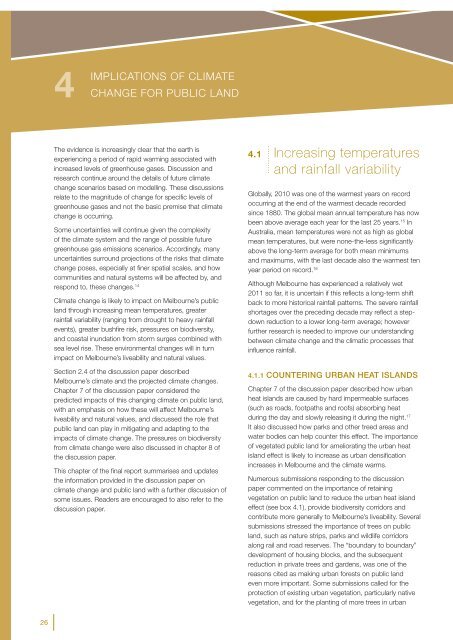Metropolitan Melbourne Investigation - Victorian Environmental ...
Metropolitan Melbourne Investigation - Victorian Environmental ...
Metropolitan Melbourne Investigation - Victorian Environmental ...
Create successful ePaper yourself
Turn your PDF publications into a flip-book with our unique Google optimized e-Paper software.
4<br />
IMPLICATIONS<br />
OF CLIMATE<br />
CHANGE FOR PUBLIC LAND<br />
The evidence is increasingly clear that the earth is<br />
experiencing a period of rapid warming associated with<br />
increased levels of greenhouse gases. Discussion and<br />
research continue around the details of future climate<br />
change scenarios based on modelling. These discussions<br />
relate to the magnitude of change for specific levels of<br />
greenhouse gases and not the basic premise that climate<br />
change is occurring.<br />
Some uncertainties will continue given the complexity<br />
of the climate system and the range of possible future<br />
greenhouse gas emissions scenarios. Accordingly, many<br />
uncertainties surround projections of the risks that climate<br />
change poses, especially at finer spatial scales, and how<br />
communities and natural systems will be affected by, and<br />
respond to, these changes. 14<br />
Climate change is likely to impact on <strong>Melbourne</strong>’s public<br />
land through increasing mean temperatures, greater<br />
rainfall variability (ranging from drought to heavy rainfall<br />
events), greater bushfire risk, pressures on biodiversity,<br />
and coastal inundation from storm surges combined with<br />
sea level rise. These environmental changes will in turn<br />
impact on <strong>Melbourne</strong>’s liveability and natural values.<br />
Section 2.4 of the discussion paper described<br />
<strong>Melbourne</strong>’s climate and the projected climate changes.<br />
Chapter 7 of the discussion paper considered the<br />
predicted impacts of this changing climate on public land,<br />
with an emphasis on how these will affect <strong>Melbourne</strong>’s<br />
liveability and natural values, and discussed the role that<br />
public land can play in mitigating and adapting to the<br />
impacts of climate change. The pressures on biodiversity<br />
from climate change were also discussed in chapter 8 of<br />
the discussion paper.<br />
This chapter of the final report summarises and updates<br />
the information provided in the discussion paper on<br />
climate change and public land with a further discussion of<br />
some issues. Readers are encouraged to also refer to the<br />
discussion paper.<br />
4.1 Increasing temperatures<br />
and rainfall variability<br />
Globally, 2010 was one of the warmest years on record<br />
occurring at the end of the warmest decade recorded<br />
since 1880. The global mean annual temperature has now<br />
been above average each year for the last 25 years. 15 In<br />
Australia, mean temperatures were not as high as global<br />
mean temperatures, but were none-the-less significantly<br />
above the long-term average for both mean minimums<br />
and maximums, with the last decade also the warmest ten<br />
year period on record. 16<br />
Although <strong>Melbourne</strong> has experienced a relatively wet<br />
2011 so far, it is uncertain if this reflects a long-term shift<br />
back to more historical rainfall patterns. The severe rainfall<br />
shortages over the preceding decade may reflect a stepdown<br />
reduction to a lower long-term average; however<br />
further research is needed to improve our understanding<br />
between climate change and the climatic processes that<br />
influence rainfall.<br />
4.1.1 Countering urban heat islands<br />
Chapter 7 of the discussion paper described how urban<br />
heat islands are caused by hard impermeable surfaces<br />
(such as roads, footpaths and roofs) absorbing heat<br />
during the day and slowly releasing it during the night. 17<br />
It also discussed how parks and other treed areas and<br />
water bodies can help counter this effect. The importance<br />
of vegetated public land for ameliorating the urban heat<br />
island effect is likely to increase as urban densification<br />
increases in <strong>Melbourne</strong> and the climate warms.<br />
Numerous submissions responding to the discussion<br />
paper commented on the importance of retaining<br />
vegetation on public land to reduce the urban heat island<br />
effect (see box 4.1), provide biodiversity corridors and<br />
contribute more generally to <strong>Melbourne</strong>’s liveability. Several<br />
submissions stressed the importance of trees on public<br />
land, such as nature strips, parks and wildlife corridors<br />
along rail and road reserves. The “boundary to boundary”<br />
development of housing blocks, and the subsequent<br />
reduction in private trees and gardens, was one of the<br />
reasons cited as making urban forests on public land<br />
even more important. Some submissions called for the<br />
protection of existing urban vegetation, particularly native<br />
vegetation, and for the planting of more trees in urban<br />
26
















